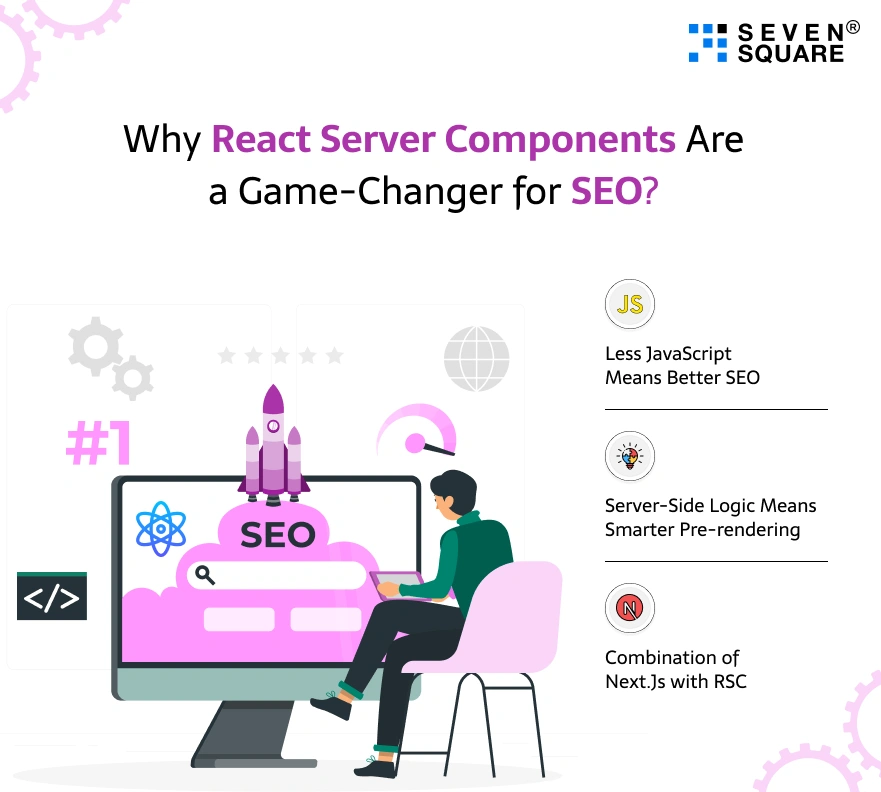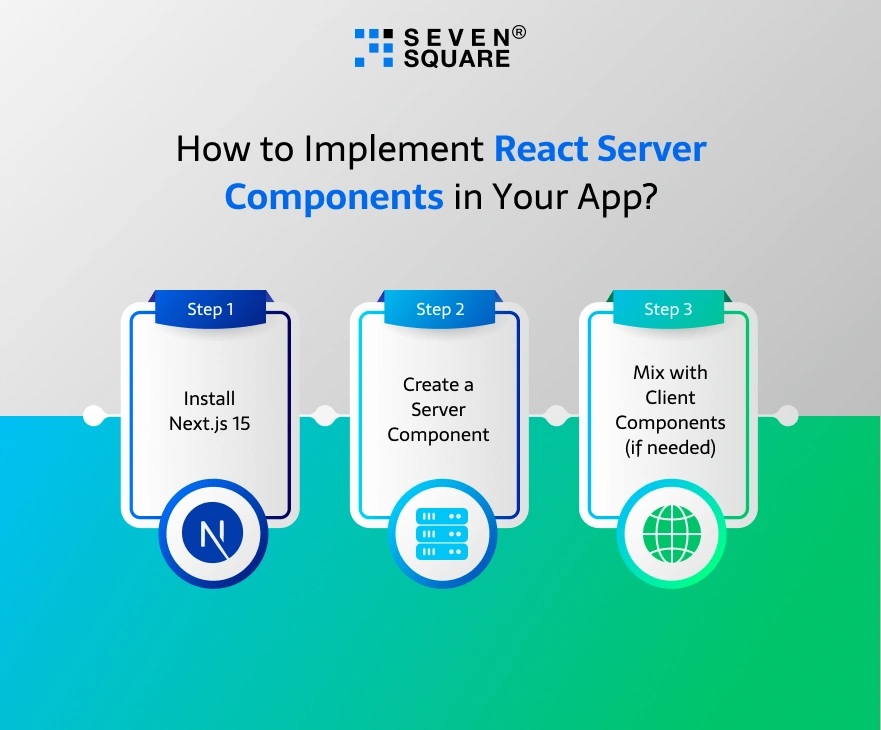Are you tired of choosing between performance, scalability, and SEO?
React Server Components (RSC) is one of the best options for you. Over the years, React has become the go-to framework to build fast, interactive user interfaces.
As web applications grew in complexity, developers faced a tricky balancing act: how to deliver fast performing, SEO-friendly, and build scalable full stack apps?
That’s where React Server Components come in.
The React team introduced it to solve this challenge.
RSC allows you to render components on the server without sending unnecessary JavaScript to the browser.
Smaller bundles, faster load times, and better SEO all without sacrificing user experience.
That’s why more people are searching terms like these all over the world:
- React Server Components tutorial
- React full stack development
- How to implement React Server Components in Next.js
Whether you are a developer exploring new technology or a business who wants to improve your web app’s performance, RSC can be perfect for you.
In this blog, we tried to explain what React Server Components are, how they work, and why they might be the future of full stack React apps.
What Are React Server Components?
React Server Components (RSC) are a powerful new feature in React to build faster & more efficient web applications with more work on the server instead of the browser.
Usually, React apps depend upon Client Components that means everything runs in the browser.
While this works it means larger JavaScript bundles, slower load times, and challenges with SEO.
React Server Components vs Client Components: What’s the Difference?
You can see the key difference where the code runs:
1. Client Components are downloaded and executed in the user’s browser. They handle interactions and rendering but slow down performance because of large bundles.
2. Server Components are rendered entirely on the server. They don’t send JavaScript to the client, which means:
- Less code is shipped to the browser
- Faster page loads
- Better SEO
- Cleaner separation between server-side logic and client-side interactivity
This separation of responsibilities makes your app easier to scale, faster to load, and more maintainable.
By using React Server Components, you can keep the benefits of a dynamic UI while minimizing heavy logic and data fetching to the server.
Whether you’re building an eCommerce platform, or a SaaS dashboard, RSC can help you deliver a smoother & more powerful user experience without sacrificing performance or search visibility.
RSC vs SSR vs SSG: What’s the Difference?
When you are building a high-performance web app, choosing the right rendering method can make or break your user experience.
So how do React Server Components (RSC) compare to Server-Side Rendering (SSR) and Static Site Generation (SSG)?
React Server Components vs SSR vs SSG
| Feature | React Server Components (RSC) | Server-Side Rendering (SSR) | Static Site Generation (SSG) |
|---|---|---|---|
| Rendering Location | Server (only renders server-specific components). | Server (renders the full page at request time). | Build time (renders static HTML). |
| Client-Side JavaScript | Minimal (server-rendered components don’t ship JS). | Full hydration required on the client. | Hydration required for interactivity. |
| Performance | High (smaller bundles, reduced JS sent to browser). | Medium (increased server load on every request). | Fast (but fixed at build time). |
| Real-Time Data | Yes (supports real-time server-side logic). | Yes | No (requires rebuild for updates). |
| SEO Optimization | Great (server-rendered content, no JS bloat). | Good (content is crawlable by search engines). | Excellent (pre-rendered HTML). |
| Flexibility | High (mix client + server components). | Medium (tightly coupled to server request cycle). | Low (not suitable for dynamic apps). |
| Best Use Cases | Full stack apps, dashboards, ecommerce, and content-rich apps. | News sites, blogs, and apps with live content. | Marketing pages, blogs, and documentation. |
Why is RSC Better?
- Smarter performance: RSC doesn’t require full hydration to make your app load faster with less JS.
- Cleaner separation: Handle data-heavy logic server-side without bloating the client.
- Better SEO and scalability: It serves fast because of SEO-friendly pages with dynamic data capabilities.
- Real-time interactivity: Like SSG you don’t have to rebuild your website for every update.
When comparing React Server Components vs SSR and React Server Components vs SSG, RSC offers the best: dynamic rendering like SSR but with better performance like SSG without the extra JavaScript baggage.
Why React Server Components Are a Game-Changer for SEO?

Search engines love fast, clean, and easily crawlable websites.
Client-heavy React apps often load tons of JavaScript before showing meaningful content which can hurt your SEO.
That’s where React Server Components (RSC) comes in to change the game.
1. Less JavaScript Means Better SEO
One of the biggest SEO issues with single-page apps is that they depend upon client-side JavaScript.
Search engines may find it difficult to crawl these pages correctly, and the initial load time can be very slow.
With React Server Components SEO, that problem gets solved.
Since RSC runs on the server, it sends fully rendered HTML to the browser with minimal JavaScript. This means:
- Faster Time to First Byte (TTFB)
- Quicker page rendering
- More crawlable content for search engines
All of this means better Core Web Vitals scores which Google now uses to rank your site.
2. Server-Side Logic Means Smarter Pre-rendering
RSC lets you fetch data and build components server-side before anything hits the user’s browser.
That gives you all the benefits of server-side rendering without loading unnecessary JavaScript to the client.
You get the flexibility of dynamic content without sacrificing SEO performance.
3. Combination of Next.Js with RSC
Use React Server Components with Next.js.
Next.js is already popular for its SEO-friendly architecture but when you combine it with RSC, you get:
- Hybrid Rendering: mix server, client, and static components.
- Better performance with built-in caching and routing.
- Cleaner separation between layout and logic.
Using React Server Components with Next.js is one of the best practices for SEO in modern full stack development.
If SEO is a priority for your web app then React Server Components are a smart & future-ready solution.
How to Implement React Server Components in Your App?

If you are ready to improve your web app’s performance then here’s your step-by-step guide on how to implement React Server Components using Next.js 15 that now supports RSC directly.
Requirements
Before you start make sure:
- You’re using Next.js 13.4 or later (Next.js 15 recommended).
- You have Node.js 18+ installed.
- Your project uses the App Router (not the older Pages Router).
Step 1: Install Next.js 15
If you are starting a new project:
npx create-next-app@latest my-rsc-app
Copied!
cd my-rsc-app
Copied!
Make sure to enable the App Router during setup.
Step 2: Create a Server Component
By default, files inside the app/ directory are treated as React Server Components.
Create a file like this:
// app/components/ServerMessage.tsx
export default async function ServerMessage() {
const res = await fetch('https://api.example.com/message');
const data = await res.json();
return <div Server says: {data.message} >
}
Copied!
Note: No “use client” directive here, this is what makes it a React Server Component.
Step 3: Mix with Client Components (if needed)
Want to use interactivity like buttons or input fields? Use “use client” in those files.
// app/components/ClientButton.tsx
'use client';
export default function ClientButton() {
return <button> onClick={() => alert('Clicked!')}>Click me <button>
}
Copied!
Then combine them in a parent layout:
import ServerMessage from './components/ServerMessage';
import ClientButton from './components/ClientButton';
export default function Home() {
return (
<div>
<ServerMessage/>
<ClientButton/>
<div>
);
}
Copied!
By following this guide and checking out a real React Server Components example, you can run a more scalable and SEO-friendly app quickly.
How We Can Help You Build with React Server Components?
We are a modern custom React development company that can modernize an existing app & even build a new one
Learn why you should think about building your own video app.
Our team is here to help you to maximize the potential of React Server Components (RSC).
With our full stack React development services, we help you build apps that are:
- Lightning-fast because of less client-side JavaScript.
- SEO-optimized using pre-rendered content and server-side logic.
- Scalable with modular architectures and smooth backend integrations.
Custom React Solutions: From dynamic dashboards to eCommerce platforms, we create personalized UIs using RSC to maximize speed and usability.
Migration to React Server Components: We help to migrate your legacy React architecture to RSC for better performance without disrupting your existing workflow.
Full-Stack App Development: Our end-to-end service covers everything from UI design and API development to database integration and deployment with the combination of Node.js and React.
Want to Future-Proof Your React App? Contact Us Today!
Real-World Use Case: Combining RSC with Full Stack Architecture
Let’s understand it with a practical example of React full stack development using React Server Components (RSC).
Suppose you are building a job board platform like a mini LinkedIn. You want:
- A fast and SEO-friendly homepage.
- Dynamic job listings.
- Personalized dashboards for users.
- A powerful admin panel for employers.
The Tech Stack
To make this scalable and maintainable, here’s a full stack setup you could use:
- Frontend: React Server Components via Next.js 15
- Backend: Node.js with Express (or even Next.js API routes)
- Database: PostgreSQL or MongoDB (using Prisma or Mongoose)
- Auth & Sessions: NextAuth.js or Clerk
- Storage & Caching: Redis or Vercel Edge Functions
How React Server Components Fit In
React Server Components helps in:
- The homepage with job categories and featured listings (server-rendered means better SEO).
- The job details page and fetching data directly from your DB on the server.
- User dashboards that hydrate only the parts that need interactivity.
It is a perfect blueprint for the modern web and React Server Components to make it possible.
FAQs
- React Server Components (RSC) are a new feature in React that allows you to render components on the server without sending unnecessary JavaScript to the browser.
- It helps to improve performance and reduce client-side load.
- React Server Components are rendered on the server and don’t include any client-side JavaScript. This makes them more efficient for non-interactive content.
- React Server Components are not a replacement but a complement to SSR (Server-Side Rendering) and SSG (Static Site Generation).
- RSC lets you keep logic on the server to improve the performance.
- RSC is best for content-heavy websites, ecommerce platforms, SaaS dashboards, and any full stack React app that needs speed, scalability, and SEO.
- Yes, our team specializes in helping businesses migrate legacy apps to use React Server Components for better performance and maintainability.